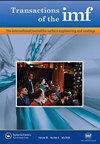Cu-MoSi2复合镀层的制备与表征
IF 1.5
4区 材料科学
Q4 ELECTROCHEMISTRY
Transactions of The Institute of Metal Finishing
Pub Date : 1999-01-01
DOI:10.1080/00202967.1999.11871245
引用次数: 7
摘要
采用电沉积技术在常规酸性硫酸铜浴中制备了Cu-MoSi - 2复合镀层。镀液中颗粒浓度、阴极电流密度、搅拌速率和搅拌方式等镀变量对复合镀层中颗粒含量(Vp)的影响介于Vp和搅拌速率之间,镀液中颗粒浓度和电流密度与掺入颗粒的性质(密度和电阻率)有关。此外,搅拌方式对cu - mosi2的Vp有较大影响。cu - mosi2复合镀层的共沉积速率和内应力受镀层参数的影响较大。测定了cu - mosi2和cu - al2o3的物理力学性能、电阻率、硬度和耐磨性。结果表明,随着Vp的增加,cu - mosi2和cu - al2o3的显微硬度和耐磨性均有所提高。与cu - al2o3相比,cu - mosi2的硬度和电阻率较低。然而,它比cu - al2o3更具磨蚀性。本文章由计算机程序翻译,如有差异,请以英文原文为准。
Preparation and characterization of Cu-MoSi2 composite coatings
Cu-MoSi 2 composite coatings were obtained by an electrodeposition technique from a conventional acid copper sulfate bath. The effects of plating variable, such as particle concentration in the bath, cathode current density, stir rate and stir type on particle content in the composite coatings (Vp) were between Vp and stir rate, particle concentration in the bath and current density were related to the nature of incorporated particles (the density and electrical resistivity). Moreover, stir type showed a great effect on Vp of Cu-MoSi 2 . The codeposition rate and internal stress of Cu-MoSi 2 composite coatings were greatly influenced by plating variables. The physicomechanical properties electrical resistivity, hardness and wear resistance of Cu-MoSi 2 and Cu-Al 2 O 3 were determined. It was established that microhardness and wear resistance increased with the increase of Vp for both Cu-MoSi 2 and Cu-Al 2 O 3 . The hardness and electrical resistivity of Cu-MoSi 2 were lower compared with Cu-Al 2 O 3 . However, it was more abrasive than Cu-Al 2 O 3 .
求助全文
通过发布文献求助,成功后即可免费获取论文全文。
去求助
来源期刊

Transactions of The Institute of Metal Finishing
工程技术-材料科学:膜
CiteScore
3.40
自引率
10.50%
发文量
62
审稿时长
3 months
期刊介绍:
Transactions of the Institute of Metal Finishing provides international peer-reviewed coverage of all aspects of surface finishing and surface engineering, from fundamental research to in-service applications. The coverage is principally concerned with the application of surface engineering and coating technologies to enhance the properties of engineering components and assemblies. These techniques include electroplating and electroless plating and their pre- and post-treatments, thus embracing all cleaning pickling and chemical conversion processes, and also complementary processes such as anodising. Increasingly, other processes are becoming important particularly regarding surface profile, texture, opacity, contact integrity, etc.
 求助内容:
求助内容: 应助结果提醒方式:
应助结果提醒方式:


